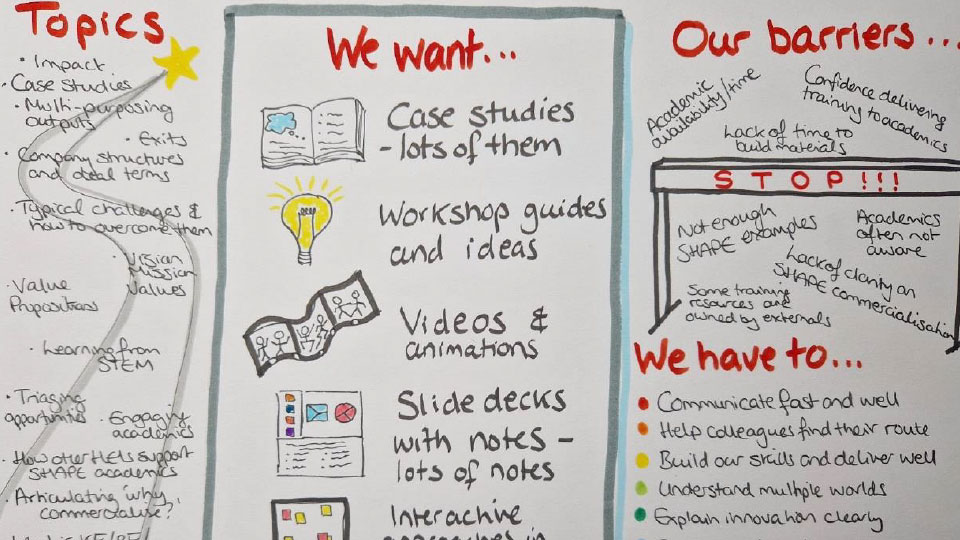Key points
- There is a great need, and great potential, for research-rich commercial innovation to add high quality years to later life.
- Researchers can help startup founders understand the problems they’re tackling and develop and test effective and engaging solutions.
- Researchers can benefit from working with startups to create unique and rich datasets on real-world applications of research insights.
- In collaborations between academics and startups, founders and researchers need to understand each other’s priorities and choose a partnership model that best suits the individuals and the context.
- More interdisciplinary research, and research that learns from people who live well in later life, could help provide strong foundations for innovation.
Innovation for an ageing population
The realities of the world’s ageing population hardly need repeating. There are more than 12 million people aged over 65 in the UK, and the estimated proportion of people around the world above this age has been predicted to increase from 9.3% today to 16% by 2050.1,2
Of course age is just a number. There is great diversity in our experience of ageing; biology, attitudes and environment all have an influence. But we know that transitions in later life are often accompanied by needs for products and services that are currently unmet. There is a growing need for innovations that improve the quality of life for older adults, and the spending power of this group is only expected to increase.
There is significant potential for commercially successful innovation that provides value for older adults, sustainably and on a large scale. We see a number of ways in which building close ties between social science research and startups could help achieve this potential, while at the same time offering new opportunities for research.
Building evidence with research-rich startups in later life
One of the earliest challenges for founders looking to build an evidence based product or service is to understand what is already known on the topic (i.e. the existing empirical evidence and published research). This can be difficult in fields where there are not yet well-established interventions because existing research that will help to understand what is effective, engaging and will gain traction with users, can be dispersed across fields and difficult to interpret. Researchers can play an important role in collating and reviewing that evidence to provide a well-informed base for innovation.
Researchers can also play a valuable role in helping founders design and execute experiments that are essential to product development – for example, research to measure engagement and effectiveness. A rigorous approach to research is particularly important in areas such as health where quality evidence is needed not only for an effective solution, but also to avoid harm, convey credibility and comply with regulations.
For researchers, working with founders can provide an opportunity to create unique and rich ‘real-world’ datasets that are hard to come by in academic research, and bring insight back into the academic literature. It also offers researchers a chance to put their knowledge and skills into practice in applied ways that benefit people in the here and now.
Founders and researchers may also be able to support each other when it comes to reaching new audiences. For researchers, working with startups can allow them to reach participant groups in very different and interesting contexts that may not be possible through traditional academic routes. For founders, researchers may be able to support engagement with specific groups of participants or patients, and build confidence to talk to diverse groups on sensitive topics and in a responsible and ethical way.
You can find some examples of later-life startups that have embraced research to learn from existing literature, involve users throughout, and test innovative solutions, in this recent blog by my colleague Clarisse for the Centre for Ageing Better.
Encouraging collaboration
Whilst there are many benefits of working together, the worlds that startups and academics inhabit are in some ways very different. To give just a few examples, founders may not have skills in evidence-based approaches, and often work to timescales that are more rapid and iterative than other sectors, especially academic research. They may need to adopt a longer-term approach to the development of relationships with people in the academic community, while academics may need to become more comfortable with the rapid ‘test-and-learn’ approach that characterises startup research. Some researchers may have limited experience in applying research to commercial innovation, and lack incentives for this work in a ‘publish or perish’ environment.
For these reasons it is important that partnerships are grounded in clear communication and an understanding of each other’s priorities and constraints. In our work we’ve seen researchers and founders work together in a number of different ways. For example researchers can be founders of startups, join founders as permanent members of their team, through temporary secondments, as consultants, or they can work with founders in mutually beneficial partnerships. Working in partnership provides opportunities to apply for grant funding that neither researchers nor founders would be eligible or competitive to apply for alone.
Pursuing research to advance later life innovation
For researchers who are keen to see greater application of research, commercial innovation can be an incredibly effective tool. There are a number of ways in which researchers can maximise the potential of later life innovation.
Continuing and increasing efforts to build links between disciplines is important. When applying findings, founders may need to bring numerous fields together in order to understand the most effective methods, for example combining tech feasibility with desirability, or behavioural science with clinical interventions. More research that links different disciplines around an important problem to be solved will help give a head start.
In later life, there is a great deal of research about the problems and health conditions that people face, but much less that shares learning from people who are thriving and ageing well. Similarly there has been work to move away from negative, stigmatising language around ageing, but relatively little research around the language that resonates well with older adults. Research on ageing well and positive visions of ageing could help to deliver products and services that appeal to people’s abilities and ambitions.
Digital technology offers an opportunity to target products to the people who will benefit from them most, or tailor products for a more personalised solution. However, there is currently a lack of tools and resources to help segment older adults into meaningful categories. Large search engines such as Google and Bing only offer partners the ability to target ads to one ‘over 65’ age group. Reliance on broad chronological age brackets, rather than a deep understanding of different segments of older people in terms of their preferences and behaviours, could severely limit the ability to reach people with relevant innovations. Research that provides a more informative picture of the different journeys and characteristics of older people would help to build more desirable products and reach the right people.
Conclusion
The need for innovation to add quality years to later life has never been greater. Our first venture builder programme on this topic has created promising opportunities to make a difference in this space, and developed new and varied partnerships between founders and researchers.
Now we need more researchers to take up the opportunities presented by working within or in partnership with startups. Not only will this make ventures more successful in providing desirable and useful products that improve people’s lives, but it will also provide opportunities for research that improves our understanding of interventions in later life.
You can read the full ‘Building ventures to improve the quality of later life’ report on our website.
Zinc is now partnering with UKRI on the Healthy Ageing Catalyst Awards, offering researchers up to £62,500 (fEC) and a programme of support from Zinc to translate research into products or services that add quality to later life.
Photo credit: Andrea Piacquadio via Pexels




